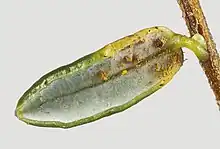Naohidemyces vaccinii
Naohidemyces vaccinii is a plant pathogen that affects members of the Vaccinium and Tsuga genera, causing leaf rust on lingonberries, blueberries, and cranberries, and early needle cast on hemlocks.[1] Naohidemyces vaccinii is found on the Vaccinium genus in Canada, the United States (AK, ME, NH), the United Kingdom, Europe, Russia, China, Korea, and Japan, and on hemlock in AK, ID, WA in the United States, BC in Canada, and Japan.[1]
| Naohidemyces vaccinii | |
|---|---|
 | |
| N. vaccinii, formerly N. vacciniorum, on leaf of Vaccinium oxycoccos | |
| Scientific classification | |
| Domain: | Eukaryota |
| Kingdom: | Fungi |
| Division: | Basidiomycota |
| Class: | Pucciniomycetes |
| Order: | Pucciniales |
| Family: | Pucciniastraceae |
| Genus: | Naohidemyces |
| Species: | N. vaccinii |
| Binomial name | |
| Naohidemyces vaccinii | |
| Synonyms | |
Taxonomy
Naohidemyces vaccinii is a basidiomycete rust fungi with a number of different synonyms, including Pucciniastrum vaccinii[2] and Pucciniastrum myrtilli,[3] but was moved to the Naohidemyces genus due to its dome-shaped covering over the aecia.[4] N. vaccinii is now thought to be the western form of the fungi, and Thekopsora minima as the eastern form.[5]
Pathology
Naohidemyces vaccinii causes leaf rust on the leaves of the Vaccinium host, and chlorosis and early abscission on both Vaccinium and Tsuga,[1] to which neither is fatal but can be a drain on fruit yield.[5]
Life cycle
Naohidemyces vaccinia is wind-borne, and initially forms yellow-orange urediniospores in pustulates on the underside of Vaccinium leaves in midsummer, which reinfect Vaccinium leaves, building up inoculum for reinfection. This is followed by flat telia crusts in late summer for overwintering, although rarely on lingonberries. Teliospores germinate from telia in spring, from which basidia form, releasing basidiospores to Tsuga species. Once alighting on Tsuga needles in the spring, pyncia are formed. Finally in early summer, yellow-orange aeciospores form in shallow conical aecia on the underside of the needles in two rows following the length of the needle.[1][2][5]
Disease impact
Leaf rust is most common on cultivated Vaccinium and relatively rare in wild populations. It is a relatively benign disease, and has little direct impact on crops, but has become an epidemic in rare occasions, particularly to cultivated blueberries.[5]
Controls
Fungicides have been shown to be effective against N. vaccinii, but not all are registered for blueberries, cranberries, or lingonberries. Applications depend on climate and species, as Vaccinium that keep their leaves throughout the year may need to be treated far earlier than the first sign of leafing out.[5] Removing Tsuga or other wild, evergreen Vaccinium hosts within 0.5 km of crops can be beneficial in breaking the sporulation cycle.[5]
References
- Polashock, James J. Redaktor. Caruso, Frank Lawrance (1949– ). Redaktor. Averill, Anne L. Redaktor. Schilder, Annemiek C. Redaktor. (2017). Compendium of blueberry, cranberry, and lingonberry diseases and pests. APS Press The American Phytopathological Society. p. 131. ISBN 978-0-89054-536-2. OCLC 1050853087.
{{cite book}}: CS1 maint: multiple names: authors list (link) - Allen, Eric Andrew, 1955– (1996). Common tree diseases of British Columbia. Pacific Forestry Centre. ISBN 0-662-24870-8. OCLC 35976392.
{{cite book}}: CS1 maint: multiple names: authors list (link) - Arthur, Joseph Charles (1934). Manual of the Rusts in the United States and Canada. Lafayette, IN: Purdue Research Foundation Lafayette, IN. pp. 18–19. hdl:2027/mdp.39015006930831.
- Sato, Katsuya (1993). "Morphology, taxonomy, and nomenclature of Tsuga-Ericaceae rusts". Transactions of the Mycological Society of Japan. 34: 47–62 – via CABdirect.org.
- Polashock, James J.; Caruso, Frank L.; Averill, Anne L.; Schilder, Annemiek C., eds. (January 2017). Compendium of Blueberry, Cranberry, and Lingonberry Diseases and Pests, Second Edition. The American Phytopathological Society. pp. 27–29. doi:10.1094/9780890545386. ISBN 978-0-89054-538-6.